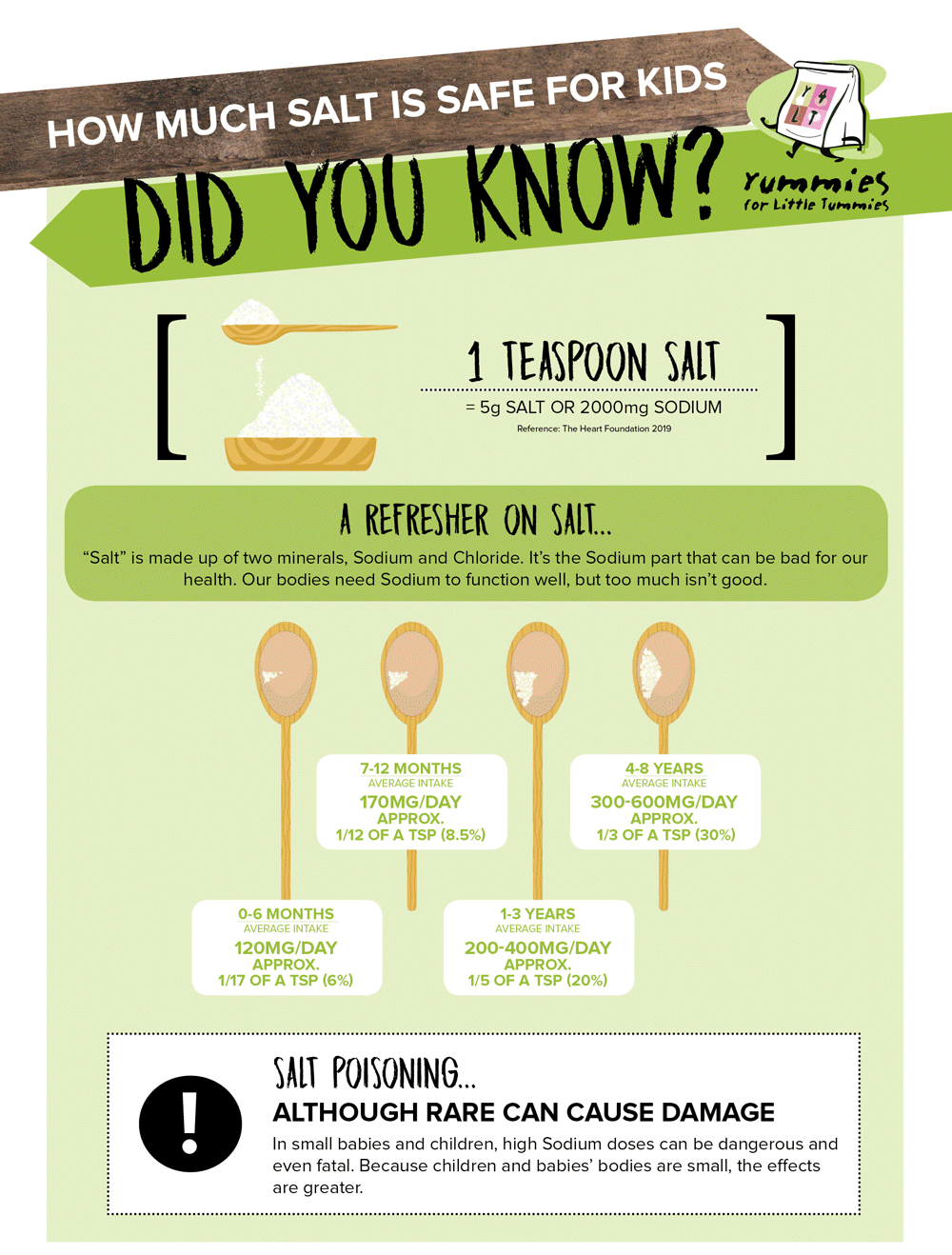
It’s not breaking news that too much salt (or Sodium) is not great for anyone, kids or adults. But do you know exactly how much salt is safe for children?
A refresher on Salt
“Salt” is made up of two minerals, Sodium and Chloride.
It’s the Sodium part that can be bad for our health. Our bodies need Sodium to function well, but too much isn’t good. Eating too much sodium can lead to high blood pressure, which is a risk for cardiovascular disease.
Salt adds flavour to foods, but eating salty foods frequently dulls our tastebuds over time so eventually, unsalted foods taste bland to us. Young children and babies who have not been regularly exposed to high salt food find unsalted foods amazingly flavoursome!
The good news is that reducing salt in our food can repair our sense of taste over time too.
Salt poisoning
In small babies and children, high Sodium doses can be dangerous and even fatal. Because children and babies’ bodies are small, the effects are greater. For example, if a small child ingested a teaspoon of salt in a sitting, it would be wise to seek medical help right away. Although it’s rare, salt poisoning can result in damage to brain cells, kidney damage and can cause seizures, coma and death. This risk is higher in children under 12 months of age.
Let’s first have a quick look at where we find Sodium in the average Aussie diet…
Salt is salt. Table salt, rock salt, sea salt, chicken salt, season salt plus many other foods that we regularly eat contain significant amounts of Sodium. Processed foods are more likely to have salt added.
Some common salt-containing foods to take care with are:
Processed meats like bacon, ham and sausages
All store-bought sauces, particularly Asian sauces like Soy Sauce
Hot chips with added salt
Store-bought BBQ roast chicken
Crisps
Ready meals and takeaways
Pickled foods
Tinned fish (and other foods) in brine
How much salt is enough for kids?
Even common everyday foods like breads and wraps, biscuits and crackers, some breakfast cereals, cheese and yoghurts all contain Sodium, so children and adults usually get plenty of it without adding extra to food in cooking or at the table.
Nearly all of us are getting way more Sodium than we need.
Infants and Sodium
The Nutrient Reference Values for Australia and New Zealand suggest the following Average Intakes (AIs) for infants. No safe upper level of intake has been established.
0-6 months average intake 120 mg/day
7-12 months average intake 170 mg/day
Children and Sodium
The Nutrient Reference Values for Australia and New Zealand suggest the following Average Intakes (AIs) and upper limits (ULs) for children.
1-3 years average intake 200-400 mg/day & upper limit 1000 mg/day
4-8 years average intake 300-600 mg/day & upper limit 1400 mg/day
9-13 years average intake 400-800 mg/day & upper limit 2000 mg/day
14-18 years average intake 460-920 mg/day & upper limit 2300 mg/day
Reference: Nutrient Reference Values for Australia and New Zealand https://www.nrv.gov.au/nutrients/sodium, sourced on 11/1/2019 How easy it is to over-do salt!
It is very, very easy to exceed a child’s recommended daily Sodium intake. Let’s take a look…
Example: A simple ham and cheese sandwich
2 x thin slices of wholemeal bread 374mg
20g (1 thin slice) of cheese 137mg
20g lean leg ham 258mg
5g butter 39mg
TOTAL = 808mg
Reference: Calculated usingFood Standards Australia & New Zealand (FZANZ), NPC database files 2011, downloaded 11/1/2019.
Without eating any other foods, a 3-year-old who ate this ham and cheese sandwich above has already eaten double their average intake of Sodium and is marching fast towards the upper limit.
At Yummies, we go the extra mile to make sure that our menus contain some Sodium but not too much for your little ones. We even have our baker prepare a special lower Sodium bread recipe just for us, we eliminate butter and we roast our own meats adding herbs and spices for flavour instead of salt.
So next time you’re preparing dinner or a snack for your little ones, look at the Sodium content on the Nutrient Information Panel of your ingredients. Lower salt alternatives and fresh food will help you keep salt at a safe level for your family.

